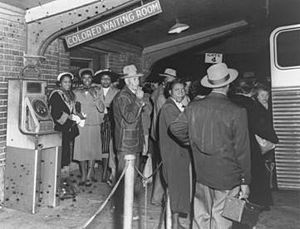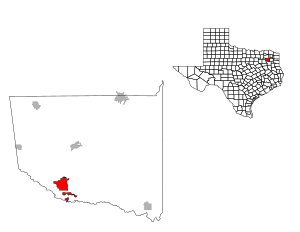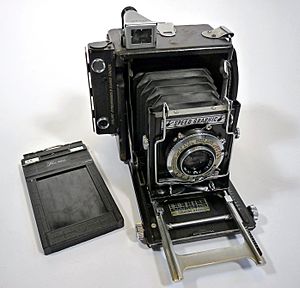R.C. Hickman facts for kids
R.C. Hickman (born Rufus Cornelius Hickman; c. 1922 – December 1, 2007) was an American photographer. He was known for his pictures of the Civil Rights Movement. This was a time when people fought for equal rights for African Americans.
Hickman took photos of important events. These included the Mansfield school desegregation incident. He also photographed famous people like Martin Luther King Jr. and Ella Fitzgerald when they visited Dallas, Texas. For many years, he worked for the Dallas Star Post, an African-American newspaper. He also took pictures for magazines like Jet and Ebony.
Hickman worked with The National Association for the Advancement of Colored People (NAACP). He used his camera to show unfair treatment in Dallas. For example, he photographed segregated schools for the NAACP's court cases.
His book, Behold the People (1994), shows many of his photos from the Civil Rights era. Hickman's work often showed the daily lives of African Americans during this time. He photographed schools, colleges, clubs, and restaurants.
Contents
Early Life and Learning
Rufus Cornelius Hickman was born in 1922 in Mineola, Texas. In the late 1920s, his family moved to Dallas. This was during the Great Depression, a time when many people lost their jobs. His father, who worked on trains, found a job as a cook.
When he was young, Hickman sold newspapers and magazines. This helped him learn about the world of publishing.
Hickman later went to Tillotson College in Austin. This college was started for African American students. He later married his wife, Ruth Kay.
Photography in World War II
Hickman joined the U.S. Army during World War II. This was a very important time for him. He became an Army photographer. This job taught him how cameras work and helped him find his own style. He learned many skills from other soldiers, especially when he was in Japan.
Learning After the War
After World War II, Hickman returned to Texas. He studied at the Southwest School of Photography. He learned more about the art of photography. He also started working in a darkroom at a photo studio.
Photography Career
Newspaper Work
Hickman had many jobs in the news photography world. He was a circulation manager for the Dallas Star Post. This meant he made sure newspapers were delivered. He traveled to many newspaper companies across the United States. He worked in this role for 12 years. This helped him understand the news business. He also took photos for the newspaper's articles.
Hickman also took pictures for other Dallas newspapers. These included the Dallas Times Herald and the Dallas Express. He also worked for the Kansas City Call. He used his early skills in selling papers to work in newspaper sales and advertising.
African-American Magazines
Many of Hickman's photos appeared in African-American magazines. They were used for everyday life stories or Civil Rights articles. Not many African American photographers worked professionally in Dallas during the Civil Rights Movement. However, magazines like Jet and Ebony had many African American photojournalists. This gave Hickman a great chance to grow his career.
Working with the NAACP
Hickman spent much of his career working for the NAACP. This group was a leader in the American Civil Rights Movement. Hickman's photos were used as evidence in many court cases. They showed the unfair treatment of African Americans every day.
Helping the Dallas Civil Rights Movement
Photos of Famous People
R.C. Hickman photographed many important people who visited Dallas. He took pictures of Martin Luther King Jr. in 1956. This was during a visit to the Good Street Baptist Church. Hickman was also the main photographer at an NAACP meeting in 1956. At this meeting, Thurgood Marshall and W. J. Durham spoke. They were both African American justice lawyers.
Hickman's work in Dallas was similar to that of Calvin Littlejohn. Littlejohn photographed similar events in Fort Worth. Both photographers documented many of the same famous people as they toured both cities.
Hickman also photographed Eleanor Roosevelt, Joe Louis, and Ella Fitzgerald.
Dallas School Segregation Case
Hickman helped the NAACP document the Dallas School Segregation Court Case in 1954. This case was part of the larger Brown vs. Board of Education case. Hickman often testified in court. He showed the unfairness of segregated schools in Dallas.
He compared Booker T. Washington High School (for African-American students) with Woodrow Wilson High School (for white students). His photos showed the big differences in science and biology classrooms.
Mansfield School Desegregation Incident
In 1956, Hickman was taking photos in Mansfield. He was gathering evidence of unfair segregation for the NAACP. He became involved in an incident at Mansfield High School. About 300 to 400 people were protesting against desegregation. Hickman photographed the poor conditions of the segregated schools. Some people chased him, and he had to flee to Fort Worth.
Being chased and facing violence was common for photographers during the Civil Rights Movement. Hickman, along with others like Charles Moore and Flip Schulke, faced danger while documenting events.
Hickman's Book: Behold the People
Behold the People: R.C. Hickman's Photographs of Black Dallas 1949–1961 was published in 1994. It was put out by The Briscoe Centre for American History at the University of Texas. The book collects photos Hickman took while documenting the Civil Rights Movement in Dallas. He had given these photos to the University in 1985. The pictures are from the 1950s and 1960s, when Hickman was most active.
His Photography Style
Hickman used a Speed Graphic camera for many of his photos. His old photos are usually 4x5 film negatives.
Hickman's photos often showed the daily lives of African Americans. He captured them in places like nightclubs, schools, colleges, or restaurants. He showed their everyday struggles in a very honest way. His work often showed the differences between African American communities and white communities. This was clear in his photos of school facilities during the Dallas School Segregation case.
Hickman's style was special for his time. Many photographers then showed protests and violence. But Hickman focused on daily life. This less common theme has become important for understanding the Civil Rights Movement. His photos help us see the many different people and activities involved.
Later Life and Recognition
Retirement and New Work
Hickman stopped his photography career in the 1970s. He then started working in retail management. He managed a company called Decorative Interiors Incorporated. He also shared his photography knowledge. He gave workshops and lectures at schools in Dallas.
Awards and Praise
Hickman received many awards for his work. These awards recognized his role in the Civil Rights Movement in Dallas. For example, a Dallas group started the R.C. Hickman Young Photographers Workshop. It teaches young students how to take pictures.
Annette Strauss and Steve Bartlett, who were mayors of Dallas, praised Hickman's work. The Dallas/Fort Worth Association of Black Journalists also honored him.
When Hickman died in 2007, Eddie Bernice Johnson spoke about him. She was a representative for Texas. She told the House of Representatives about Hickman's "irreplaceable contributions" to Dallas and Texas.
Exhibitions and Archives
Much of Hickman's work is now available in archives. The Briscoe Center at the University of Texas has many of his photos. This archive includes photos from 1945 to 2005. They are grouped by subject, like schools, funerals, clubs, colleges, and news. This shows what Hickman usually photographed. The Briscoe Center also has online exhibitions of Hickman's and Calvin Littlejohn's photos.
Hickman's work has also been shown at the Dallas Historical Society. This group keeps Dallas's history alive. In 2015, photos from Behold the People were displayed there.
Another exhibition, Struggle for Justice: Four Decades of Civil Rights Photography, opened in 2017. It shows the challenges and successes of the Civil Rights Movement. This exhibition features Hickman and other photographers. It covers topics like "signs of segregation" and "the risks and threat of violence" faced by activists.
Hickman's work was also shown during Black History Month in 2019. It was displayed at Dallas City Hall and the Briscoe Center.
Death
Hickman died on December 1, 2007. He passed away at his home in Oak Cliff, Dallas, at the age of 85.
See also





